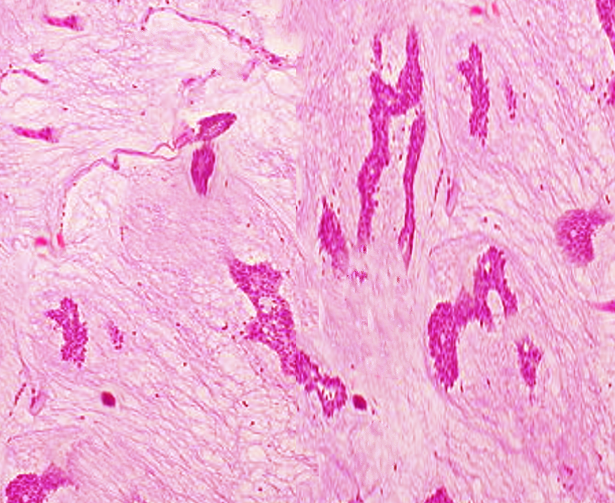[1]
Kaoku S,Konishi E,Fujimoto Y,Tohno E,Shiina T,Kondo K,Yamazaki S,Kajihara M,Shinkura N,Yanagisawa A, Sonographic and pathologic image analysis of pure mucinous carcinoma of the breast. Ultrasound in medicine & biology. 2013 Jul
[PubMed PMID: 23683410]
[2]
Di Saverio S,Gutierrez J,Avisar E, A retrospective review with long term follow up of 11,400 cases of pure mucinous breast carcinoma. Breast cancer research and treatment. 2008 Oct
[PubMed PMID: 18026874]
Level 2 (mid-level) evidence
[3]
Zhang L,Jia N,Han L,Yang L,Xu W,Chen W, Comparative analysis of imaging and pathology features of mucinous carcinoma of the breast. Clinical breast cancer. 2015 Apr
[PubMed PMID: 25523373]
Level 2 (mid-level) evidence
[4]
Weigelt B,Horlings HM,Kreike B,Hayes MM,Hauptmann M,Wessels LF,de Jong D,Van de Vijver MJ,Van't Veer LJ,Peterse JL, Refinement of breast cancer classification by molecular characterization of histological special types. The Journal of pathology. 2008 Oct;
[PubMed PMID: 18720457]
[5]
Toikkanen S,Eerola E,Ekfors TO, Pure and mixed mucinous breast carcinomas: DNA stemline and prognosis. Journal of clinical pathology. 1988 Mar;
[PubMed PMID: 2834422]
[6]
Tan PH,Tse GM,Bay BH, Mucinous breast lesions: diagnostic challenges. Journal of clinical pathology. 2008 Jan;
[PubMed PMID: 17873114]
[7]
Righi L,Sapino A,Marchiò C,Papotti M,Bussolati G, Neuroendocrine differentiation in breast cancer: established facts and unresolved problems. Seminars in diagnostic pathology. 2010 Feb;
[PubMed PMID: 20306832]
[8]
Komaki K,Sakamoto G,Sugano H,Morimoto T,Monden Y, Mucinous carcinoma of the breast in Japan. A prognostic analysis based on morphologic features. Cancer. 1988 Mar 1;
[PubMed PMID: 2827884]
[9]
Barkley CR,Ligibel JA,Wong JS,Lipsitz S,Smith BL,Golshan M, Mucinous breast carcinoma: a large contemporary series. American journal of surgery. 2008 Oct
[PubMed PMID: 18809061]
[10]
Lacroix-Triki M,Suarez PH,MacKay A,Lambros MB,Natrajan R,Savage K,Geyer FC,Weigelt B,Ashworth A,Reis-Filho JS, Mucinous carcinoma of the breast is genomically distinct from invasive ductal carcinomas of no special type. The Journal of pathology. 2010 Nov;
[PubMed PMID: 20815046]
[11]
Domfeh AB,Carley AL,Striebel JM,Karabakhtsian RG,Florea AV,McManus K,Beriwal S,Bhargava R, WT1 immunoreactivity in breast carcinoma: selective expression in pure and mixed mucinous subtypes. Modern pathology : an official journal of the United States and Canadian Academy of Pathology, Inc. 2008 Oct;
[PubMed PMID: 18469795]
[12]
Adsay NV,Merati K,Nassar H,Shia J,Sarkar F,Pierson CR,Cheng JD,Visscher DW,Hruban RH,Klimstra DS, Pathogenesis of colloid (pure mucinous) carcinoma of exocrine organs: Coupling of gel-forming mucin (MUC2) production with altered cell polarity and abnormal cell-stroma interaction may be the key factor in the morphogenesis and indolent behavior of colloid carcinoma in the breast and pancreas. The American journal of surgical pathology. 2003 May;
[PubMed PMID: 12717243]
[13]
Komenaka IK,El-Tamer MB,Troxel A,Hamele-Bena D,Joseph KA,Horowitz E,Ditkoff BA,Schnabel FR, Pure mucinous carcinoma of the breast. American journal of surgery. 2004 Apr
[PubMed PMID: 15041505]
[14]
Wilson TE,Helvie MA,Oberman HA,Joynt LK, Pure and mixed mucinous carcinoma of the breast: pathologic basis for differences in mammographic appearance. AJR. American journal of roentgenology. 1995 Aug
[PubMed PMID: 7618541]
[15]
Chang YW,Kwon KH,Lee DW, Synchronous bilateral mucinous carcinoma of the breast: case report. Clinical imaging. 2009 Jan-Feb
[PubMed PMID: 19135933]
Level 3 (low-level) evidence
[16]
Memis A,Ozdemir N,Parildar M,Ustun EE,Erhan Y, Mucinous (colloid) breast cancer: mammographic and US features with histologic correlation. European journal of radiology. 2000 Jul
[PubMed PMID: 10930764]
[17]
Okafuji T,Yabuuchi H,Sakai S,Soeda H,Matsuo Y,Inoue T,Hatakenaka M,Takahashi N,Kuroki S,Tokunaga E,Honda H, MR imaging features of pure mucinous carcinoma of the breast. European journal of radiology. 2006 Dec
[PubMed PMID: 16963218]
[18]
Yang M,Li X,Chun-Hong P,Lin-Ping H, Pure mucinous breast carcinoma: a favorable subtype. Breast care (Basel, Switzerland). 2013 Mar
[PubMed PMID: 24715844]
[19]
Garcia Hernandez I,Canavati Marcos M,Garza Montemayor M,Lopez Sotomayor D,Pineda Ochoa D,Gomez Macias GS, Her-2 positive mucinous carcinoma breast cancer, case report. International journal of surgery case reports. 2018
[PubMed PMID: 29291541]
Level 3 (low-level) evidence
[20]
Park S,Koo J,Kim JH,Yang WI,Park BW,Lee KS, Clinicopathological characteristics of mucinous carcinoma of the breast in Korea: comparison with invasive ductal carcinoma-not otherwise specified. Journal of Korean medical science. 2010 Mar
[PubMed PMID: 20191033]
[21]
Toikkanen S,Kujari H, Pure and mixed mucinous carcinomas of the breast: a clinicopathologic analysis of 61 cases with long-term follow-up. Human pathology. 1989 Aug;
[PubMed PMID: 2545592]
Level 3 (low-level) evidence

